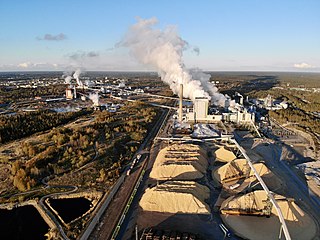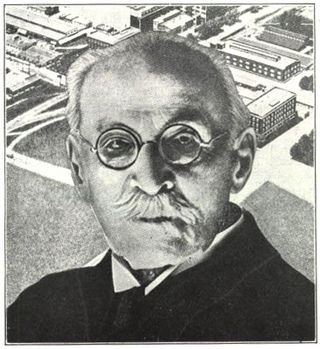
Wallpaper is a material used in interior decoration to cover the interior walls of domestic and public buildings. It is usually sold in rolls and is applied onto a wall using wallpaper paste. Wallpapers can come plain as "lining paper", textured, with a regular repeating pattern design, or, much less commonly today, with a single non-repeating large design carried over a set of sheets. The smallest rectangle that can be tiled to form the whole pattern is known as the pattern repeat.

Paperboard is a thick paper-based material. While there is no rigid differentiation between paper and paperboard, paperboard is generally thicker than paper and has certain superior attributes such as foldability and rigidity. According to ISO standards, paperboard is a paper with a grammage above 250 g/m2, but there are exceptions. Paperboard can be single- or multi-ply.

Linoleum is a floor covering made from materials such as solidified linseed oil (linoxyn), pine resin, ground cork dust, sawdust, and mineral fillers such as calcium carbonate, most commonly on a burlap or canvas backing. Pigments are often added to the materials to create the desired colour finish. Commercially, the material has been largely replaced by sheet vinyl flooring, although in the UK this is often still referred to as lino.

Papier-mâché, frequently miswritten as paper mache, is a composite material consisting of paper pieces or pulp, sometimes reinforced with textiles, and bound with an adhesive, such as glue, starch, or wallpaper paste.

Stucco or render is a construction material made of aggregates, a binder, and water. Stucco is applied wet and hardens to a very dense solid. It is used as a decorative coating for walls and ceilings, exterior walls, and as a sculptural and artistic material in architecture. Stucco can be applied on construction materials such as metal, expanded metal lath, concrete, cinder block, or clay brick and adobe for decorative and structural purposes.

Banana paper is a type of paper created from banana plant bark or banana peel fibers. Banana paper has a lower density, higher stiffness, higher disposability, higher renewability, and higher tensile strength compared to traditional paper. These qualities are due to the cellular composition of banana fiber, which consists of cellulose, hemicellulose, and lignin.
Crown Wallpaper, also known as the Crown Wallpaper Company, was an agglomeration of some of the largest wallpaper manufacturers in the United Kingdom in 1899. The agglomeration included founding member Arthur Sanderson & Sons Ltd. By 1904, the group had acquired the majority of companies specialising in relief decoration, which included Lincrusta-Walton and Anaglypta. The company had premises in Darwen, Lancashire.

A pulp mill is a manufacturing facility that converts wood chips or other plant fiber sources into a thick fiber board which can be shipped to a paper mill for further processing. Pulp can be manufactured using mechanical, semi-chemical, or fully chemical methods. The finished product may be either bleached or non-bleached, depending on the customer requirements.

Lincrusta is a deeply embossed wallcovering, invented by Frederick Walton. Walton was already known for patenting linoleum floor covering in 1860. Lincrusta was launched in 1877 and was used in a host of applications from royal homes to railway carriages. Many examples over a hundred years old can still be found throughout the world.

Nonwoven fabric or non-woven fabric is a fabric-like material made from staple fibre (short) and long fibres, bonded together by chemical, mechanical, heat or solvent treatment. The term is used in the textile manufacturing industry to denote fabrics, such as felt, which are neither woven nor knitted. Some non-woven materials lack sufficient strength unless densified or reinforced by a backing. In recent years, non-wovens have become an alternative to polyurethane foam.

Victorian decorative arts refers to the style of decorative arts during the Victorian era. Victorian design is widely viewed as having indulged in a grand excess of ornament. The Victorian era is known for its interpretation and eclectic revival of historic styles mixed with the introduction of Asian and Middle Eastern influences in furniture, fittings, and interior decoration. The Arts and Crafts movement, the aesthetic movement, Anglo-Japanese style, and Art Nouveau style have their beginnings in the late Victorian era and gothic period.
Cotton paper, also known as rag paper or rag stock paper, is made using cotton linters or cotton from used cloth (rags) as the primary material. Prior to the mid-19th century, cotton paper was the main form of paper produced, with pulp paper replacing cotton paper as the main paper material during the 19th century. Although pulp paper was cheaper to produce, its quality and durability is significantly lower. Although pulp-paper quality improved significantly over the 20th century, cotton paper continues to be more durable, and consequently important documents are often printed on cotton paper. Different grades of cotton paper can be produced.

Frederick Edward Walton, was an English manufacturer and inventor whose invention of Linoleum in Chiswick was patented in 1863. He also invented Lincrusta in 1877.

A folding table is a type of folding furniture, a table with legs that fold up against the table top. This is intended to make storage more convenient and to make the table more portable. Many folding tables are made of lightweight materials to further increase portability.
A wallpaper steamer is an electrical device which boils water continuously in order to produce steam. This steam is then allowed to pass through a narrow bore tube to a face plate. This face plate is then held against a wallpapered wall. The steam passes through the paper, saturates the backing paper and partially dissolves the desiccated wallpaper paste. This then allows the wallpaper to be pulled from, or scraped off the wall.
Marburger Tapetenfabrik is one of the oldest wallpaper manufacturers in Europe and sells its products under the “Marburg Wallcoverings” brand name. The Marburger Tapetenfabrik developed the first free-repeat pattern wallpapers, fabric and profile vinyl wallpapers as well as non-woven wallpaper.

Leather wallpaper is a type of wallpaper used in various styles for wall covering. It is often referred to as wrought leather. It is often gilded, painted and decorated. Leather was used to cover and decorate sections of walls in the houses of the rich, and some public buildings. Leather is pliable and could be decorated in various ways.

Kashmiri papier-mâché is a handicraft of Kashmir that was brought by Muslim saint Mir Sayyid Ali Hamadani from Persia in the 14th century to medieval India. It is based primarily on paper pulp, and is a richly decorated, colourful artifact; generally in the form of vases, bowls, or cups, boxes, trays, bases of lamps, and many other small objects. These are made in homes, and workshops, in Srinagar, and other parts of the Kashmir Valley, and are marketed primarily within India, although there is a significant international market. The product is protected under the Geographic Indication Act 1999 of Government of India, and was registered by the Controller General of Patents Designs and Trademarks during the period from April 2011 to March 2012 under the title "Kashmir Paper Machie".
Confil is a wet-laid nonwoven fabric made from a blend of polyester and cellulose. The International Paper Company acquired the manufacturing process from Feldmühle in 1968, and marketed Confil as a disposable fabric for domestic and hospital use. Although the product was too late to market to take advantage of the 1960s paper clothing fad, International Paper promoted it for general clothing use, positioning the product as superior to paper in feel and durability, but cheap enough to throw away. Despite limited adoption in the fashion industry, demand justified construction of a $16 million factory in Lewisburg, Pennsylvania to increase production volumes. As the price of cotton more than doubled during the 1970s, Confil found use in other specialty applications such as wallpaper, construction fabrics, and geotextiles. In the early 21st century, Confil is largely used in filtration media.

William Morris (1834-1898), a founder of the British Arts and Crafts movement, sought to restore the prestige and methods of hand-made crafts, including textiles, in opposition to the 19th century tendency toward factory-produced textiles. With this goal in mind, he created his own workshop and designed dozens of patterns for hand-produced woven and printed cloth, upholstery, and other textiles.













